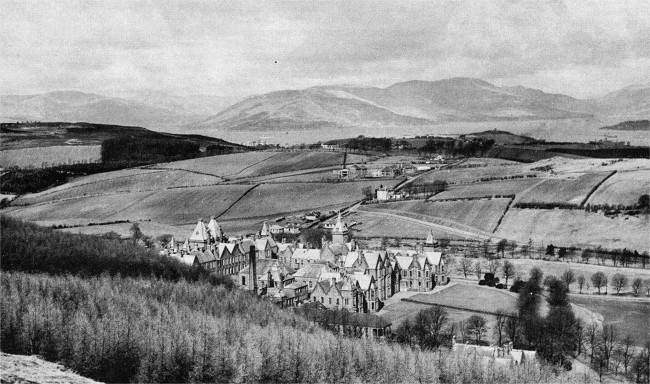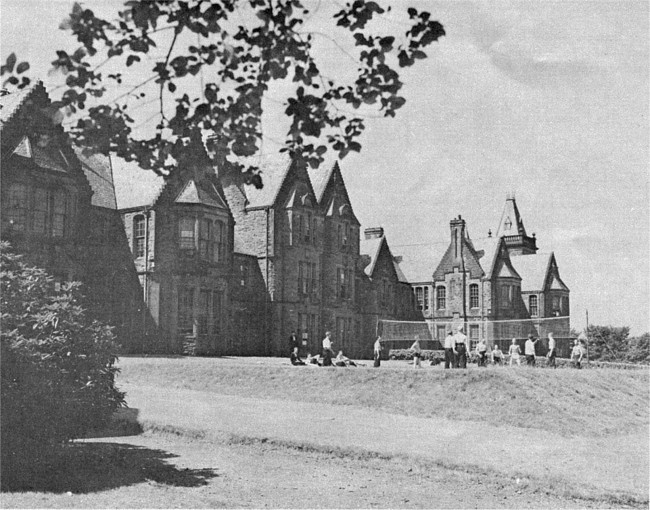HMCS Niobe, shore establishment WWII, "in the valley"

HMCS Niobe, Ravenscraig, Greenock, Scotland was an RCN shore establishment in the U.K. during the Second World War. At the start of the war, Canada had no naval shore establishment or manning depôt in the U.K.; HMCS Dominion [1] was paid off (de-commissioned) on 28 Feb 1941 and re-commissioned as HMCS Niobe the following day 1 March 1941 based in Plymouth. This site proved problematic for lack of space and German bombing activities, was paid off 30 June 1941, and re-commissioned 15 Dec 1941 (these dates subject to research, as a gap of five and a half months is surprising despite many RCN activities becoming more centred in Halifax, NS) in Greenock. This 'stone frigate' was finally paid off after the end of the war on 9 February 1946. The following text is adapted from the The Crowsnest, v.12, no.11, Sep 1960.
The establishment name HMCS Niobe was again placed in commission "in the late 1940s. The one in London [sic] resumed the name of her wartime predecssor, NIOBE ..."; also, Niobe II was commissioned as a depôt in Belfast, Northern Ireland, "9 April 1956 - 17 January 1957, established to carry on her books the personel standing by BONAVENTURE when she was fitting out." (Freeman, D.J., "Canadian Warship Names", Vanwell, 2000.
Greenock, Scotland, has not forgotten the sailors and WRENs from Canada who served there at HMCS Niobe during the Second World War and, if one may judge from, the reminiscences of "R.M.S." in the' June 1 issue of the Greenock Telegraph, the memories are pleasant.
Greenock's continued interest in the RCN was shown in an earlier issue of the Telegraph, which published an historical article during May in observance of the RCN's JUbilee.
The more recent article, which appeared under the heading "Canadian Naval Jubilee Recalls Old 'Niobe'" and which is reprinted here, ascribes the transfer of HMCS Niobe from Plymouth to Greenock to the savage bombing to which the south coast city was subjected. This was probably the explanation current at the time and, on the face of it, a logical one. However, the official explanation is that the change was solely for operational reasons.
With Canadian warships operating in increasing numbers in United Kingdom waters an accountant officer was attached to the Royal Naval Barracks, Devonport, in July 1940. This was a prelude to the commissioning of HMCS Dominion at Plymouth on October 1 of that year. Because the cable address of the RCN establishment was often confused with that of the Canadian High Commissioner in London, the name was changed to HMCS Niobe on March 1, 1941. The establishment at Plymouth was short-lived under its new name. In June, the Newfoundland Escort Force, based on St. John's, was established, with a consequent shift in the area of operations of HMC Ships. Niobe was paid off on June 30, 1941.
But the tempo of war increased - more Canadian warships were entering United Kingdom waters, more Canadian naval personnel were being drafted to the British Isles for duty or training. On December 15, 1941, HMCS Niobe was again commissioned - this time at Greenock, Scotland - to act as parent ship to Canadian warships and also as an accounting base, manning pool and hospitalization centre.
The rest of the story is told in warm, human terms by "R.M.S."
NIOBE, as every schoolboy knows, was. a mythological Theban mother of twelve who became the personification of maternal grief when she was slain by Apollo. It was perhaps only natural for classically-minded Greenockians to read into the name of that Canadian "stonewall frigate", HMCS Niobe, some allusion to sorrowing wartime mothers.
A sentimental touch - but all wrong. Greenock's Canadian naval base was named after an old four-funneled cruiser, first ship of the Canadian Navy. Whatever it means to Canada, Niobe to Greenock means the Canadian Naval Base which came into being at Smithston in 1942.
I well remember, just prior to the closing of Niobe after the war, a Canadian rhyming off to me his views of the Greenock base:-
May her name forever stand,
In the history of the Navy
Her name spread o'er the land.
She's muddy when it's raining,
She's dirty when it's hot;
But it's no use complaining ...
It's the only home we've got!
This Canadian was one of thousands from the Dominion who found a temporary haven at our one-time Poor Law Infirmary, known once as Smithston Asylum, and now as Ravenscraig Hospital. For five years in the Second World War, Smithston was under the flag of the Royal Canadian Navy. It was the only establishment of its kind in Britain taken over by the Canadians, and from the visitors Greenock learned much about the land of the Maple Leaf. It was only by accident that the Canadians ever came to this district at all!
At the beginning of the European war they were stationed at Plymouth. When the English port was blitzed the Canadian Navy was shipped to Greenock. Here they found a home, moored out at the Inverkip Road, in a building meant for a very different purpose. At one time, Niobe was the base for 3,000 Canadian sailors, and 300 Canadian wrens - of whom about 100 were on loan to the Royal Navy. Greenock learned to love these men and women from the Canadian towns and prairies.
On numerous occasions wrens and sailors told me that, while they were longing to get back to Canada, they would always have a warm spot in their hearts for Greenock. Indeed many of the Canadians who spent some of the war years at Ravenscraig have re-visited the district in peace time. I have spoken to a number of them on trans-Atlantic liners at the Tail of the Bank. Many found sweethearts in Greenock, and while some took their brides to their Canadian homes, others married in Greenock and are still here.
The war-time activities at Niobe were covered by a blanket of censorship, of course.
As a member of the Telegraph staff, however, I had certain privileges which I treasured. Many a social gathering I attended, and I was always struck with the warmth of Canadian hospitality. At the front of the main entrance to Niobe were 52 temporary huts which housed personnel and offices. At the top of the steps was the quarterdeck, neatly roped off. From there the main entrance was reached, and the first thing the visitor saw was a lifebuoy with HMCS Niobe painted on it. Somehow the old building had the air of a real ship.

Everything was always spic and span. Everybody darted smartly around in typical "pusser" fashion. In spite of this, I must admit I felt more at home at Niobe than in any Royal Navy establishment.
The red tape was not quite so much in evidence, and the atmosphere was noticeably friendlier.
Smithston did not undergo much in the way of structural alterations to become a naval base. About all I can remember is that a former waiting room was transformed into an officers' mess. And what a transformation! It had the most modern cocktail bar I had seen until that time.
On the walls were the murals in Walt Disneyish style of Hollywood stars and famous band leaders. The women celebrities had a mermaid look that would have done honour to Davy Jones' locker.
This was the exception rather than the rule. On the top floor of the building were the officers' cabins - which had not undergone any real change from pre-war Smithston times.
The confidence shown by the Canadians in the press was such that I was shown, on occasions, places definitely "out of bounds" to the ordinary individual. I recollect a visit to the communications room where I was impressed by their 120-line private telephone exchange.
It was all very business-like. All the offices and departments were wired up. In the torpedo room there was a broadcasting apparatus from which a daily "Niobe News Bulletin" - some of it in humorous vein-was broadcast to all parts of the building-even the galley. Niobe had concert talent, too. It had its own variety party, a military band, and a dance band. The military band gave more than 100 broadcasts, including a number from London.
There were football, baseball, hockey, softball and ice-hockey teams. I remember many a lively visit to Paisley Ice Rink, and the fun and frolics which followed the games.
But these Canadians did not only provide entertainment for themselves. I recollect several occasions when the matelots "put round the hat" at Niobe to bring joy into the lives of young people.
They gave many a treat to local children. They purchased perambulators and presented them to the matron of the orphanage at Smithston for her young charges.
There was an inconspicuous group of "old salts" at Niobe I well remember. They were nursing sisters who had served in hospitals in different parts of Canada and were brought over to restore health to sick men, and the wounded from ships. They did a grand job.
Niobe had many a distinguished visitor. Among those I recollect were Cardinal Villeneuve, the Hon. W. C. Woodward, Lieutenant-Governor of British Columbia; the Rt. Hon. Vincent Massey, Canadian High Commissioner to the United Kingdom; Naval Minister Angus L. Macdonald, and the Chief of the Naval Staff, Vice-Admiral Jones.
There were a number of officers of outstanding personality in charge at Niobe, including Captain J.R. Hunter (LCdr, Acting Captain, RCNVR, seniority 1 January 1943. Ed.) and Cdr. E.M. Detchon (LCdr, Acting Commander, RCNVR, seniority 1 January 1944 Ed.)
Eventually the reins of office at the base were in the hands of Cdr. C.E.M. Donaldson (LCdr, Acting Cdr, RCNVR, seniority 1 March 1936), now Member of Parliament for Roxburgh, Selkirk and Peebles. In the Autumn of 1945 the Canadian flag was struck at Smithston and the building turned gradually back to its normal function as a hospital.
The name HMCS Niobe, however, has not been erased from the naval lists. It is at present borne by the Royal Canadian Navy depot in London. - R.M.S.
[ Back ] Footnote 1: HMCS Dominion was commissioned 1 October 1940 as a manning pool and RCN Pay Office. Located in Devonport (Plymouth), specifically the "village" or suburb of Stoke on the East bank of the Tamar River, firstly at the Damerel School, then at 6 Havelock Terrace, finally at the [Royal] United Services (Orphan) Home for Girls at 13 Sutherland Road which later became the Polish Navy Southern Command. HMCS Dominion was paid off 28 February 1941. It has been incorrectly suggested that HMCS Dominion was London based, due to the confusion with the telegraphic address 'Dominion, London' of Canada House on Trafalgar Square, home of the High Commission of Canada since 1925.
